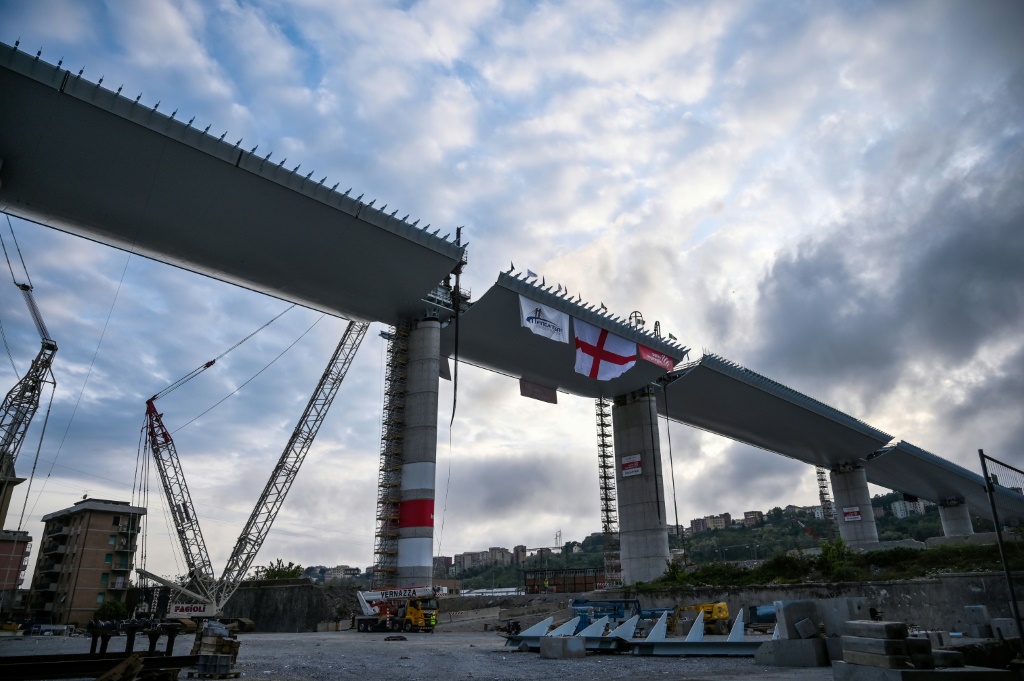Can Italian infrastructure reboot post-virus economy?
The completion of the Genoa bridge was hailed as a sign of renewal for Italy (Marco BERTORELLO)
Rome (AFP) – A sleek new bridge in Genoa built in record time is being acclaimed in Italy as a model for rebuilding the economy by investing in major infrastructure projects.
Such stimulus is sorely needed as the country slides towards its worst recession since World War II because of the coronavirus pandemic.
The government admits it badly needs to renovate crumbling roads, bridges and railways, and doing so could also save lives. Yet the possible impediments are many — from funding to political will, bureaucracy and a recent safety reports scandal.
The completion of the Genoa bridge was hailed as a sign of renewal for Italy, where over 28,000 people have died in the coronavirus pandemic and millions risk losing their jobs due to an economically-crippling nationwide lockdown.
The hi-tech flyover “is a symbol for the whole of Italy. An Italy that can rise again, that will roll up its sleeves, that will not allow itself to be beaten,” Prime Minister Giuseppe Conte said at the unveiling ceremony.
As ships in the maritime city’s port sounded their horns to mark the completion, Conte paid homage to the 43 people who plunged to their deaths when the former span, the Morandi flyover, collapsed in 2018.
Other such tragedies could be averted by funding roads, bridges, schools, hospitals and climate change adaptation, which would create jobs and fuel short- and long-term growth.
Almost 750 public works worth 62 billion euros ($68 billion) were on hold at the end of last year, from large bridges to small-town schools, according to Italy’s construction lobby ANCE.
Kick-starting them would create 962,000 jobs, it said.
Sceptics wonder where the money will come from — with Italian GDP forecast to contract by between eight and 10 percent this year — and whether the political will exists in a fragile coalition government.
– Disasters in the making –
The Morandi — one of the world’s longest concrete bridges when it opened in 1967 — was a symbol of rebirth for postwar Italy, which was modernising rapidly, throwing up thousands of concrete viaducts, tunnels and bridges.
But by 2018, Italy ranked 22nd out of 28 EU countries for the efficiency of its transport network.
While its ancient Roman cement structures still stood, it discovered that modern versions had much shorter life-spans.
The Morandi collapse followed a string of similar incidents and it finally set alarm bells ringing.
Most of Italy’s 6,500 kilometres (4,000 miles) of motorway are managed by private companies, which must ensure their bridges are safe.
A post-disaster probe found evidence of poor maintenance by Autostrade per l’Italia, which is among Italy’s biggest toll-road operators and owned by the powerful Benetton family.
It also unearthed allegedly falsified safety reports by the motorway unit and its sister company for several other bridges, in what prosecutors suspected were attempts to cut costs.
Autostrade per l’Italia denies any wrongdoing and widespread calls for it to be stripped of its concession have as yet come to nothing.
It is not the only operator failing to keep its network safe.
The latest bridge to crumble in Italy, managed by state-owned ANAS, fell last month into a river between Liguria and Tuscany. It would have been heavily used at the time, had it not been for the virus lockdown.
There are 20 more bridges at risk of collapse across the country, and 200 road tunnels that do not meet European safety standards, according to investigative reports seen and cited by the Repubblica daily in January.
– ‘Give the country a plan’ –
“I am begging you on my knees, give the country a great plan — like the Marshall Plan — to restart it,” Pietro Salini, CEO of Italy’s biggest builder Salini Impregilo, told Conte last week.
Salini Impregilo, which was charged with reconstructing the Genoa bridge with shipbuilder Fincantieri, wants to create a construction hub called Project Italy by combining its assets with those of struggling building companies.
It says it would help restart numerous projects that are currently blocked across the country. But its biggest challenge may be generating sufficient liquidity.
Since the shutdown, Conte has unveiled stimulus packages worth 750 billion euros ($830 billion). He has also, however, had to apologise several times for long delays in payments.
Last week, he lifted the lockdown early for construction projects considered to have strategic importance, from schools, prisons and council housing, to disaster risk reduction for extreme weather events.
Environmentalist lobby Legambiente has urged the government to make the climate crisis its infrastructure priority, after nearly 160 extreme events in 2019 — flash floods, whirlwinds and landslides — killed 42 people.
A historic high tide that washed through Venice in December, causing millions of euros of damage to Saint Mark’s Basilica alone, was blamed both on climate change and huge delays to a vast flood barrier project.
The country’s schools are also in an alarming state. Fifty-five percent of school buildings in Italy were built before the 1974 anti-seismic regulations were brought in, according to ANCE.
Some 43 percent of them are in areas classified as high-risk for earthquakes. Over 70 percent do not have fire safety certificates. Stories regularly hit the news about pupils evacuated over crumbling classroom ceilings.
Many have pointed out that the national closure of schools until September because of the coronavirus is the perfect opportunity for the renovation of ageing structures.
– Red tape –
The government has said it will widen the budget deficit by 55 billion euros, a “shock cure” which would see public debt in the eurozone’s third largest economy jump to 155.7 percent of GDP, from the already mammoth 134.8 percent in 2019.
It pledged to speed up new public works that are in an advanced planning stage and maintain existing ones.
And it also promised to “urgently and drastically simplify administrative procedures” in critical sectors, including construction, the green economy and Internet connectivity.
Italy is famed for its red tape and projects often drag on for years, plagued by bureaucracy.
The country has at least 50 large infrastructure projects that are blocked but have been signed off on, with the money ready to spend, from a high-speed train in Sicily to the widening of a motorway in Tuscany, ANCE says.
Financial experts caution however that some of those funds may be withdrawn and channelled to projects considered more essential due to the crisis, or with immediate prospects of a payoff.
The National Council of Engineers (CNI) is one of many bodies to have sent the government proposals on how best to use infrastructure to reboot the country and shape it along different lines.
“Cities have proved fragile spaces in sanitary terms,” the council’s head Armando Zambrano told AFP.
He suggested investment could be made to encourage a return to the countryside, revitalising hundreds of abandoned little towns across Italy, and improving internet connections to encourage working from home.
– Mafia –
Zambrano acknowledged, though, that he had little hope the government would actually do the necessary tape-cutting. Reforms aimed at reducing bureaucracy in construction, in 2018 and 2019, were disappointing.
“There are always elements of the government that are distrustful, who equate big projects with corruption, ever since the Mani Pulite (Clean Hands) scandal,” he said, referring to widespread political corruption in the 1990s.
The crisis has sparked a fierce debate over whether projects are being obstructed by overly-strict corruption and mafia controls, with some even calling for them to be scrapped.
Italy’s anti-corruption authority has warned the rules are essential to prevent mafia infiltration.
“Organised crime groups would certainly be interested in getting a slice of public contracts, construction is where they thrive,” criminology expert Anna Sergi told AFP.
The powerful ‘Ndrangheta in Calabria and Camorra in Campagna have infiltrated road and airport construction, while the Cosa Nostra in Sicily prefers lower-key infrastructure projects which are easier to control, she said.
– Politically controversial –
Political economy expert Erik Jones from Johns Hopkins University said the greatest problem lay with the anti-establishment Five Star Movement, which governs Italy in coalition with the centre-left Democratic Party.
The Movement (M5S) is the largest party in government and has components within it that loathe big infrastructure projects, from the high-speed Turin to Lyon train line to a Trans Adriatic gas pipeline.
“There are many of these products that are shovel-ready, but are politically controversial, as well as being held up for bureaucratic reasons,” Jones told AFP.
Pushing forward on them would “light a spark” under M5S supporters who had regularly taken to the streets to protest such projects and were already suffering “pent-up frustration” after two months of lockdown.
The government could pick other big, less controversial pieces of infrastructure that are not shovel-ready, but it would take time to identify them and go through the entire planning process.
Jones also warned of another potential flaw in the plan.
“The Italian state is not great at paying firms that do work for it. It has a huge stockpile of arrears that it owes.”
All said, the idea of restarting the economy through massive infrastructure spending is, he says, “just pie in the sky”.
Disclaimer: Validity of the above story is for 7 Days from original date of publishing. Source: AFP.


